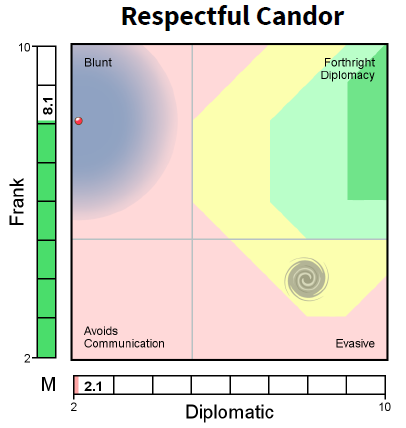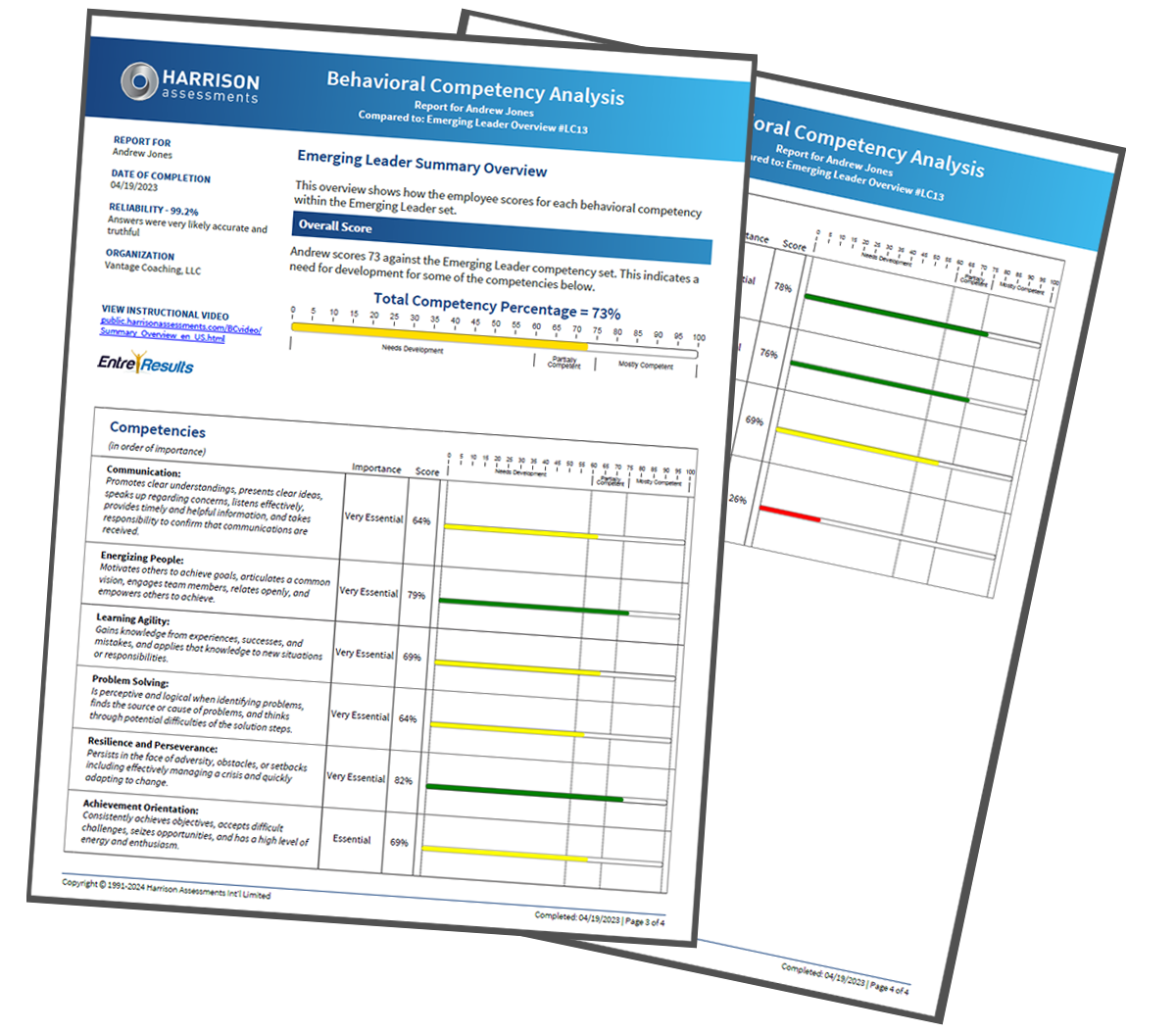The Leadership Behavior Gap: How DOING Outweighs KNOWING
Mastering Behavior Tips the Leadership Scales Toward Success
You can’t get better as a leader by continuing to do what you’re already good at. And if you don’t know what you’re already good at (and what you’re not), well … then your leadership is a crap shoot.
In This Article:
Average leaders DO what they KNOW. Competent leaders KNOW what they DO—and WHEN, WHY and HOW they do it.
There's almost always a disconnect between a leader's PERCEPTION of their behavior and the ACTUAL behavior that’s practiced.
It's easy to lean on a behavior because you think it's a strength for you. But failing to understand HOW and WHEN to use it makes it a liability.
Leaders hurt their long-term effectiveness when they stop deepening their behavior set.
Key Application:
Get data-driven and objective visibility to your leadership behaviors—the ones helping you and the ones derailing your success.
The Competency Gap
Average leaders DO what they KNOW. They “know” what leadership is. They can repeat all the buzz words, cliches and quote the latest gurus.
They think they know, but they don’t know what they don’t know. Their knowledge is limited, but they operate as if it’s not. And so the limited set of what they “see” makes them blind to the opportunity to get better.
Their leadership is on autopilot, approaching every situation the same way without realizing there are alternative behaviors available. They’re reactive, situationally deaf and opportunistically blind.
In contrast, competent leaders KNOW what they DO—and they know why, when and how they do it. They’ve learned to see themselves as others see them. They are situationally aware, and intentionally use specific behaviors appropriate for the situation in front of them.
The gap separating the two groups isn’t measure by levels of skill, it’s measured by levels of self-awareness.
Greater self-awareness gives competent leaders a more accurate picture of their actual behavior. They know themselves well enough that they recognize what’s needed upstream from when it’s needed. And they’ve practiced enough to be purposeful with their behaviors, which accelerates their development even further.
Low levels of self-awareness in average leaders creates a disconnect between their perception of their behavior and their actual behavior. This creates a self-imposed ceiling that prevents them from succeeding when the stakes increase and the environment becomes more complex.
The result: Competent leaders continue to develop and refine competent behaviors, and average leaders operate from a stagnant behavior set and get locked into leadership mediocrity.
And in case “mediocrity” isn’t sufficiently unappealing, let me clarify: “Mediocre” is a French word that originally meant “halfway up the mountain.”
Solving the Behavior Puzzle
Vince Lombardi said, “Leaders aren’t born, they’re made.” But there’s a key ingredient that must be in place to make leaders: They have to want to be great. You can’t move from leadership mediocrity to leadership competency without changing your behavior—purposefully, rather than accidentally.
This purposeful aspect is why I use the Harrison Behavioral Assessment in my coaching. It’s like a leadership X-ray, providing comprehensive, data-driven insight into my clients’ behaviors, unlocking opportunity for exploration and change.
The Harrison Assessment addresses the mediocre-competence gap by rapidly and accurately increasing self-awareness. It is the premier behavioral assessment on the market, is used in 38 languages and 61 countries around the world, and is backed by 30 years worth of research and validation.
It is the mirror that every leader who wants to be competent is looking for.
The Road to Leadership Competency
Here are three steps we must go through to master our leadership behaviors and tip leadership success in our favor.
Step 01 :: Increase Your Self-Awareness
As I’ve already stated, the gap between mediocrity and competency is best measured in terms of self-awareness. But increasing self-awareness can be tough for leaders who are focused on task execution, and not reflection or introspection.
I find that leaders who struggle with self-awareness have to get across three distinct hurdles (each with varying degrees of challenge):
Being Curious — Curiosity about how to improve your leadership comes from believing that you can get better as a leader (no matter how skilled you currently are). If you don’t genuinely believe this—at the level of a core value—then no amount of information or motivation will produce curiosity.
Embracing Personal Change — Some leaders simply don’t think change is necessary. They don’t have a vision of what they want at the end of the change process. Some leaders find it threatening. All this creates a (functionally speaking) fixed mindset. And if nothing changes, nothing changes.
They Aren’t Self-Objective — Leaders who deflect personal shortcomings will struggle to become genuinely, productively self-aware. They live in a pattern of fundamental attribution error: the cognitive bias of attributing their own mistakes or shortcomings to external factors.
Bottom Line: Lack of self-awareness means you don’t see yourself objectively, which means you don’t understand how you fit into the reality around you.
Step 02 :: Become Aware of Your Blind Spots
Overcoming the barriers in Step 01 lets you identify your behavioral blind spots, which are (as the name implies) behaviors that are undermining your effectiveness that you simply don’t see.
It’s not a question of if you have blind spots. Pretty much, if you’re breathing you’ve got some. If you aren't willing to see them, they’ll stay hidden—even to the point that you’ll deny they exist when someone alerts you about them; you’ll say you “don't see it."
Often times blind spots are associated with behaviors that we consider to be strengths. This usually happens when we over-rely on the behavior, either using it too often or in the wrong situations, and end up misusing it.
Step 03 :: Know Your Paradox Tendencies
Overcoming blind spots allows you to move to the next level of behavior change: paradoxical behavior tendencies. These are pairs of behaviors that (on the surface) appear to be opposites of each other, but they are actually complimentary and synergistic. Unbalanced paradox behaviors are actually specialized cases of blind spots—usually because we view one of the two behaviors in each pair in an unhealthy way.
Paradox behaviors are another special feature in the Harrison Behavior Assessment. A great example is a communication-related paradox called Respectful Candor. It includes the behaviors of “frankness” and “diplomacy.” Here’s how it’s represented in graph form:
Most leaders default to one or the other (as you can see in the example above, of a leader who emphases frankness in communication so much that diplomacy is virtually excluded). This default approach blinds them to the opportunity they’re missing when they can exhibit BOTH behaviors. Being able to be both frank AND diplomatic is a higher order leadership behavior.
There are 12 separate paradoxes explored in the Harrison Assessment, covering areas of interpersonal dynamics, task accomplishment, leadership, motivation, and how leaders initiate, implement and maintain the projects and people they lead.
Move Beyond Your Status Quo
If you just go by the title of this article, it might appear that I’m arguing for execution over knowledge. That’s a misunderstanding.
What may not be apprent in the title is that what we DO (behavioral competency) comes exclusively from what we KNOW (understand fully). DOING is the barometer for KNOWING: If what we KNOW is limited, then what we DO will also be limited. Self-awareness comes from deeper and more accurate knowledge.
Here are a few applications to deepen your self-awareness of your leadership behaviors …
01 :: Use Regular Reflection
This is your first step toward greater self-awareness. If reflection is new to you, it may sound soft and impractical. I assure you it is not.
I suggest doing this as a part of a disciplined reflection process. It’s an easy on-ramp, and sets a constructive framework for self-awareness. Start by reading this article: Why Reflection Is the Most Underutilized Leadership Discipline.
02 :: Ask a Trusted Partner
Start getting feedback from a trusted friend, colleague, business partner … anyone who’s seen you operate in your leadership role. But most importantly, it needs to be someone that A) has your best interests in mind, and B) will be courageous enough to tell you the truth.
Ask for …
One thing you can start doing or stop doing to be a more effective leader.
Their opinion on what blind spots you might have.
Their perspective on your behavioral inconsistencies and over-uses.
When they respond, you can ask for examples or for clarification, but don’t react, deflect or blame. Just take what they say to heart, and make a plan to start doing one thing differently.
03 :: Establish Your Baseline and Create Your Plan
The clearest step forward I offer my clients is using the Harrison Behavioral Assessment to establish a baseline for your leadership behaviors. This will identify the behaviors that are helping you and the ones derailing your leadership.
This report gives an X-ray of your behaviors in 10 critical areas of leadership competency: communication, energizing people, learning agility, problem solving, resilience and perseverance, achievement orientation, impact and influence, innovation, leading people and strategic thinking.
Imagine leading your team with clarity and confidence, knowing exactly which behaviors to leverage to build trust, resolve conflict, and drive results. This assessment reveals how to achieve that level of leadership mastery.
Along with this report, you’ll get a 30-minute debrief with me to unpack when and how these behaviors are occurring and a plan for change. You’ll walk away with a clear picture of where you are AND where you need to go in upgrading your leadership effectiveness.
I’m offering the report and the 30-minute debrief now for $295 (normally priced at $395)—it’ll be the most strategic $295 you’ll ever spend. And please know that this is not a hook: You won’t be up-sold on other services. This is a walk-away, turnkey resource for you.
Here’s how it works:
Click the Button below to purchase the $295 offer.
Complete the Assessment in 20-30 minutes at your convenience.
Get Your Personalized Report and debrief with me during a 30-minute coaching session.
Ready to begin? Just click the button …
Once the payment processes, I’ll follow up in 24-48 hours with a link to complete your assessment.
Worried about your schedule? Completing the assessment is simple: Just click on the link, choose your preferred language and respond to the questions. The entire process takes just 20-30 minutes. No crazy hoops or complicated fluff.
Got Questions? You can message me directly on Substack, reach out to me on LinkedIn or use the Contact Me from my website. I look forward to speaking with you!
Peace be with you …
Thoughts? Questions? Comments?
Leave a comment and let’s discuss…






